Annual Special:
Mini LED Industry Report
2024
Year-End Review (Part 1)
Recently, BOE’s first mass-produced 13.48-inch Mini LED automotive backlight display was installed in the well-known domestic car brand Hongqi’s flagship model “Guoya” series. In addition, the Zeekr 7X launched in October this year and the Xiaomi SU7 released in April are also equipped with 16-inch Mini LED floating screens and 16.1-inch backlit central control screens, respectively.
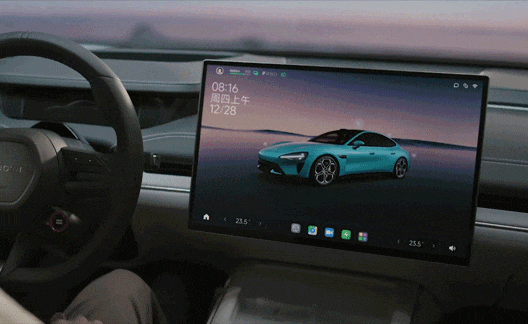
Source: Xiaomi Automotive Official Website
It is worth mentioning that in 2024, Mini LED TVs will surpass OLED for the first time, becoming the top-selling category in the high-end TV market. Chinese manufacturers such as Hisense, TCL, and Xiaomi have seen rapid growth in both shipment volume and revenue.
Mini LED was once regarded by many manufacturers as a transitional technology before the maturity of Micro LED and OLED technologies. However, as Micro LED continues to face production difficulties and the cost reduction of OLED panels remains challenging, Mini LED is making a comeback in 2024, marking a turning point for market explosion.
Part 01.
The King of Cost-Performance in Medium and Large Sizes
2024 Market Performance
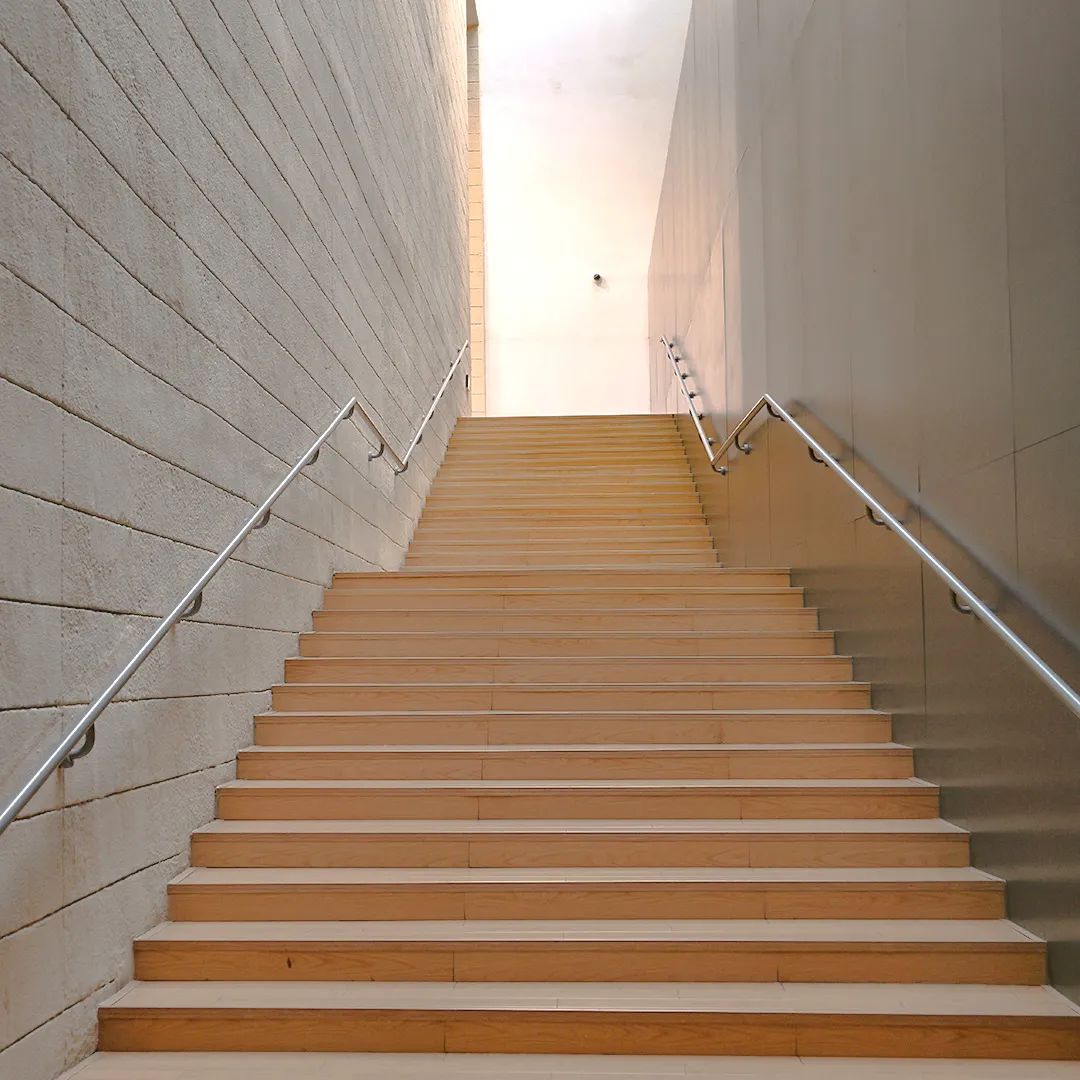
The rise of any industry is a battle for a trillion-level market, and the display industry is no exception.
After experiencing Cathode Ray Tube (CRT), Plasma Display (PDP), and Liquid Crystal Display (LCD) technologies, the most discussed next-generation display technologies in the industry mainly include three: Mini/Micro LED, Printed OLED, and Laser Display.
Among them, the OLED route chosen by Samsung and LG has long occupied the leading position in the global high-end market. Meanwhile, Chinese companies are betting on Mini LED, which, as an upgraded technology of LCD, is rapidly penetrating the high, medium, and low-end markets with its unique advantages.
01
Medium and Large Size – Mini LED Surpasses OLED for the First Time
Especially with the trend of larger TV screens, the advantages of Mini LED in the medium and large terminal market are becoming increasingly evident.
Due to the persistent challenges of cost, yield, and lifespan for OLED in large-size applications, and the continuous development of Mini LED backlight solutions and technologies, particularly in cost and visual effects, Mini LED backlight TV shipments are expected to surpass OLED for the first time in 2024, becoming the top-selling category in the high-end TV market.
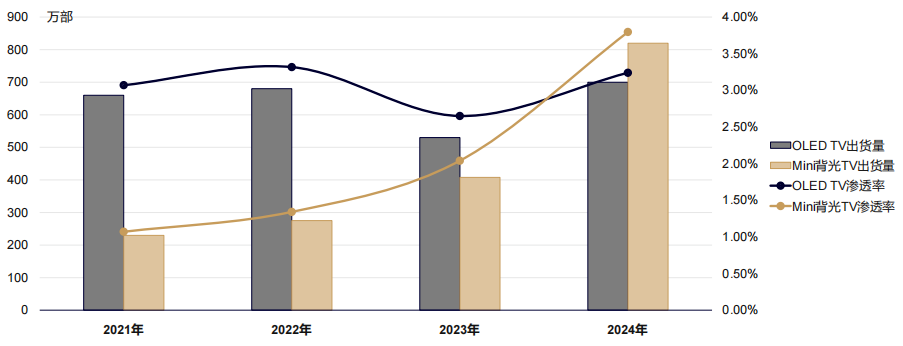
Source: Industry Research
According to relevant statistics, the shipment volume of Mini LED TVs in 2023 was 4.08 million units, and is expected to grow to 8.2 million units in 2024, a year-on-year increase of 100%.
In terms of shipment sizes, Mini LED TVs in 2024 will mainly focus on 65, 75, and 85 inches, with 85 inches being the most shipped specification, and the maximum size reaching 115 inches. In terms of brand participation, compared to OLED TVs being gradually “neglected” by most domestic mainstream manufacturers, Mini LED TVs are almost “competing among all brands”. Mini LED TVs have become the “common choice” for all color TV brands.
02
Medium Size – Automotive Displays Emerge
After the gradual increase in Mini LED technology in large-screen TVs and monitors, it has also begun to emerge in automotive display applications in recent years.
Unlike consumer electronics, automotive displays face challenges such as high design difficulty, high reliability requirements, and long testing cycles. At the same time, with the continuous development of intelligent cockpits in new energy vehicles, there is a growing demand for larger screen sizes in automotive displays, further accelerating the penetration of Mini LED in the automotive display application market.
|
Model |
Application |
Release Date |
|
Hongqi Guoya |
BOE 13.48-inch Mini LED Automotive Backlight Display |
December 2024 |
|
Zeekr 7X |
16-inch world’s first automotive-grade quantum dot film Mini LED Display |
September 2024 |
|
Xiaomi SU7 |
16.1-inch TCL Huaxing Mini LED Central Control Screen |
March 2024 |
|
YANGWANG U8 |
23.6-inch Mini LED Instrument Panel and Mini LED Co-Driver Entertainment Screen |
July 2023 |
|
Lincoln New Model Nautilus |
Dual 23.6-inch Curved 4K Ultra HD Mini LED Screen |
April 2023 |
|
Li Auto L7 |
Mini LED Safe Driving Interaction Screen |
February 2023 |
|
Feifan R7 |
Equipped with BOE and Longli Technology’s 12.3-inch Mini LED Co-Driver Screen 10.25-inch Mini LED Instrument Screen |
September 2022 |
|
Third Generation SAIC Roewe RX5 |
Equipped with Jufei Optoelectronics 27-inch 4K Mini LED Panoramic Smart Interactive Screen |
August 2022 |
|
Li Auto L9 |
Equipped with Jufei Optoelectronics Mini LED Safe Driving Interaction Screen |
June 2022 |
|
Cadillac LYRIQ |
Equipped with Innolux 33-inch Curved Mini LED Backlight Ultra Retina Screen |
June 2022 |
|
Mercedes-Benz Vision EQXX |
Developed in cooperation with Mercedes-Benz, Continental Automotive Group, and TCL Huaxing 47.5-inch Cross-A-Pillar Mini LED Display |
January 2022 |
|
NIO ET7 |
Equipped with BOE 10.2-inch HDR Mini LED Backlight Digital Instrument |
January 2021 |
Source: Public Information from the Internet
From the statistics in the above table, it is not difficult to see that with the continuous development and maturity of Mini LED technology, its application in the automotive display market is showing a trend of annual increase.
03
Small Size – OLED Still Leads
OLED has characteristics such as high cost, good visual effects, foldability, and ease of application, and is currently mainly concentrated in the small size terminal application market below 9 inches, such as tablets and mobile phones.
The shift of Apple’s iPad products from Mini LED to OLED reflects that OLED still retains a competitive advantage in display quality and design for small size terminal applications.
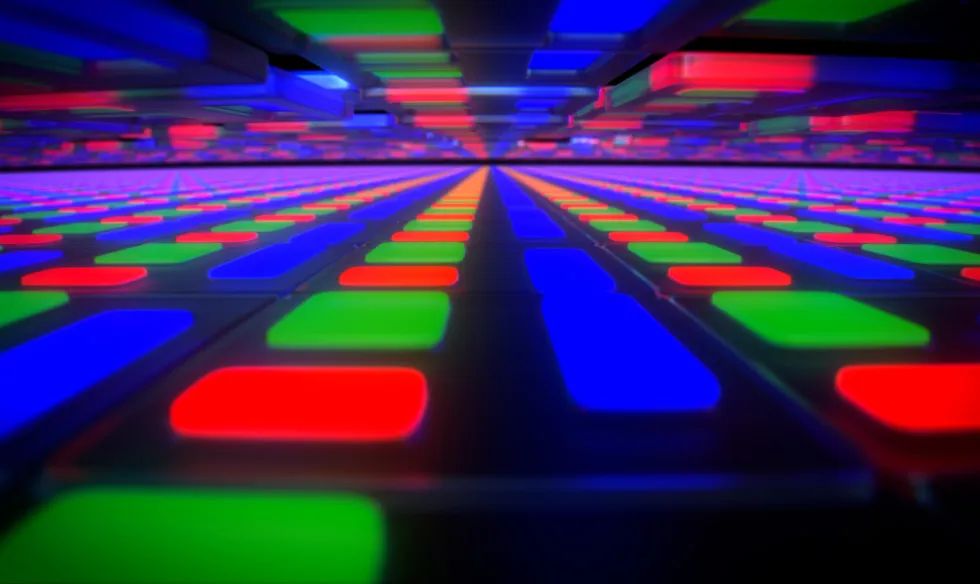
Source: Apple Official Website (OLED Technology Showcase)
In summary, the increasingly mature medium and large size TV, MNT, and other terminal application fields, as well as the gradually developing automotive display application field towards medium and large sizes, have undoubtedly become important stages for Mini LED to showcase its advantages.
Part 02.
2024 Mini LED Technology Trends
From the market dynamics, the development of Mini LED shows the following trends:
01
Further Cost Reduction
With the advancement of manufacturing technology and the expansion of production scale, the application cost of Mini LED technology has been decreasing year by year, with Mini LED backlight technology showing the most significant improvement.
The biggest change in Mini LED backlight technology in 2024 is that the solutions are becoming mature, and the cost reduction paths have gradually reached consensus in the upstream and downstream industrial chains, including PCB, LED chips, driver ICs, and process materials. For example, with Mini LED chips and PCBs:
Mini LED Chip
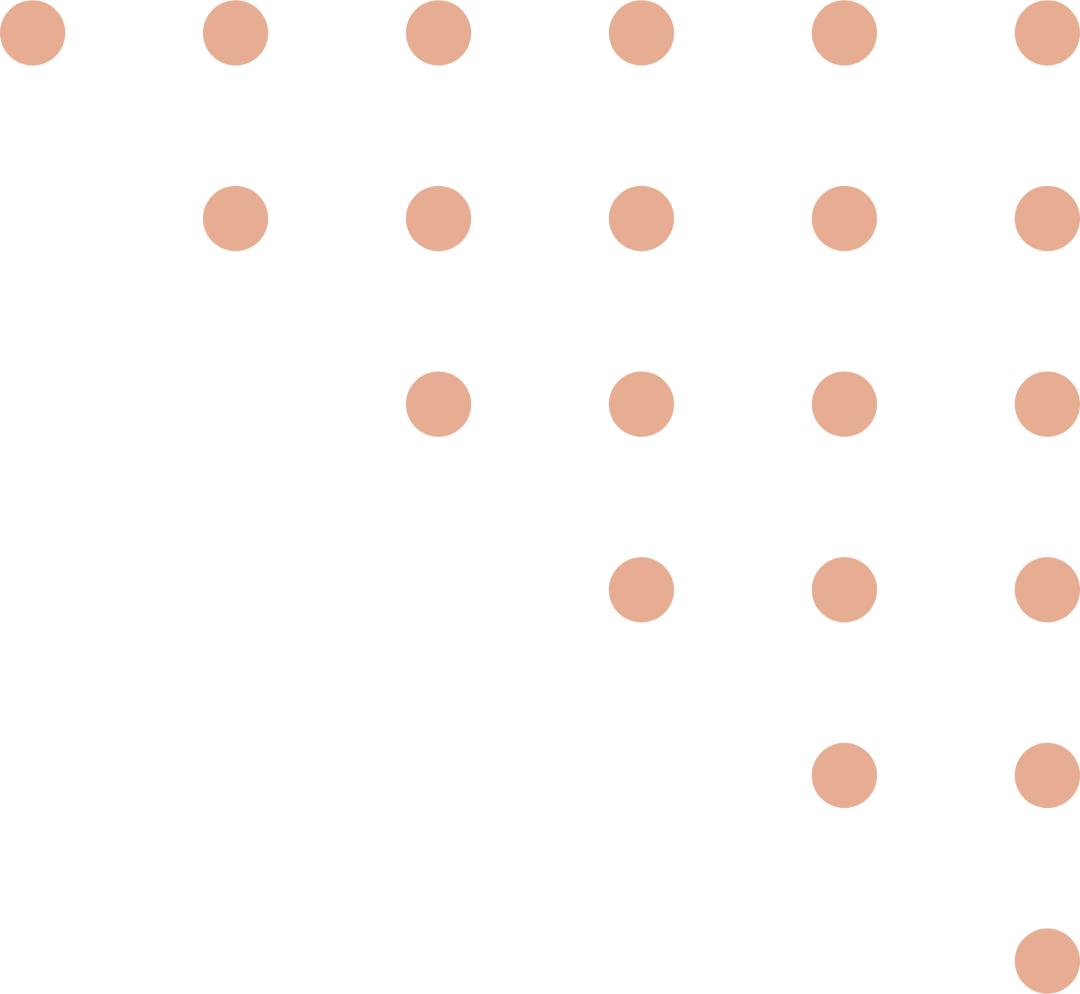
By increasing the Pitch/OD value, it is possible to reduce the number of Mini LED chips while ensuring brightness, directly achieving cost reduction.
Current Solutions:
1. Increased Light Emission Angle: Chip manufacturers increase the DBR (Distributed Bragg Reflector) structure in LED chips, using Mini lenses, large-angle lenses, and other optical design solutions.
2. High-Voltage Chip Solutions: This can enhance power, reduce driving current, and improve luminous efficiency, thereby reducing the number of LED series chips and simplifying PCB wiring design to lower costs.
PCB Board
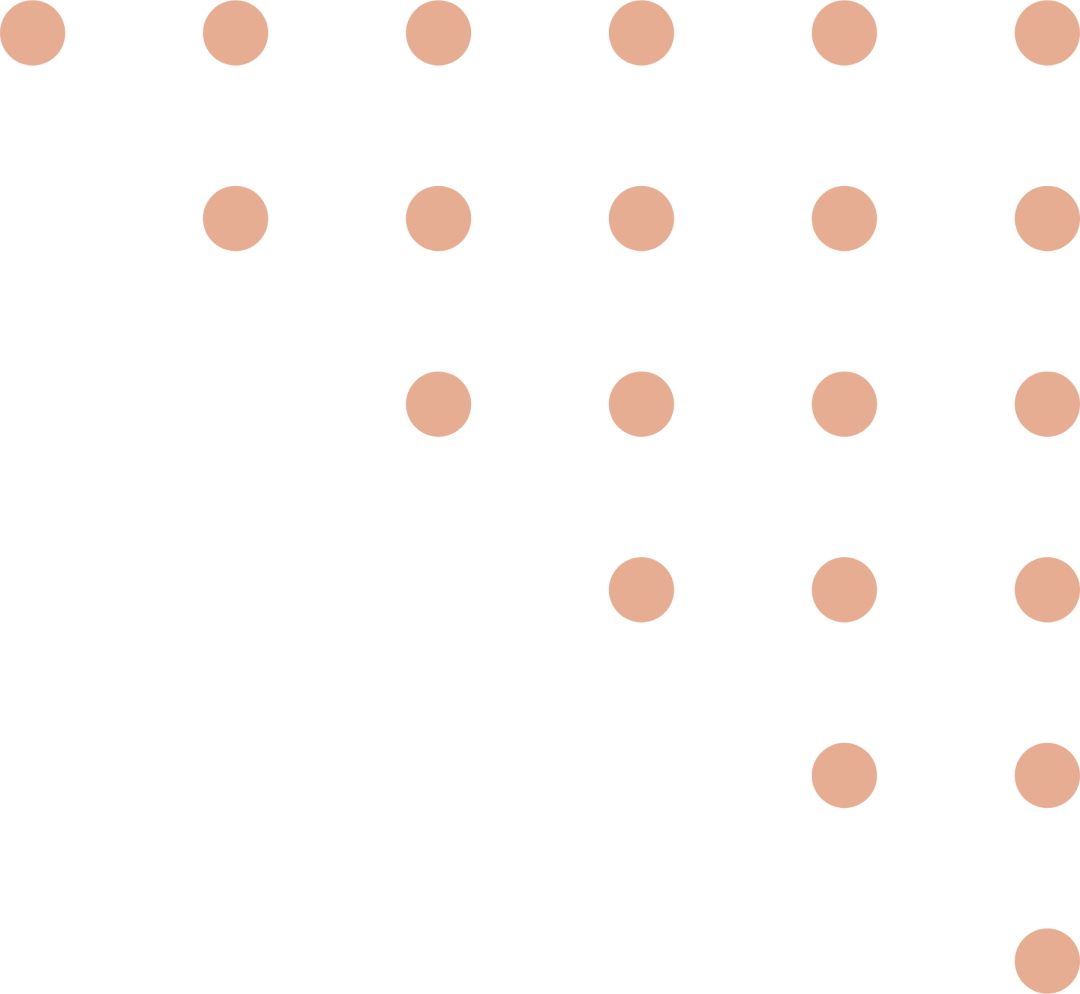
In traditional Mini LED backlighting, the cost of PCB accounts for about 30%, so there is significant room for cost reduction for this component.
Current Solutions:
1. Use cheaper materials, such as aluminum-based PCBs for TVs;
2. Use irregular boards to improve the utilization rate of single boards, optimizing from whole PCBs to fishbone shapes and then to light bar shapes, thus saving production costs.
02
Application Fields Continue to Expand
In 2024, although the performance of Mini LED in the terminal small size product application field is not as bright as that in TV and automotive terminal application markets, it has also developed to varying degrees.
In addition to high-end TVs and monitors, Mini LED backlight technology is also expected to be applied in tablets and laptops. The domestic Mini LED small size market is mainly customized, with the mainstream customized sizes being 27 inches and 32 inches.
Mini LED Backlight Products in Small Size Lamp Boards Representative Products and Specifications
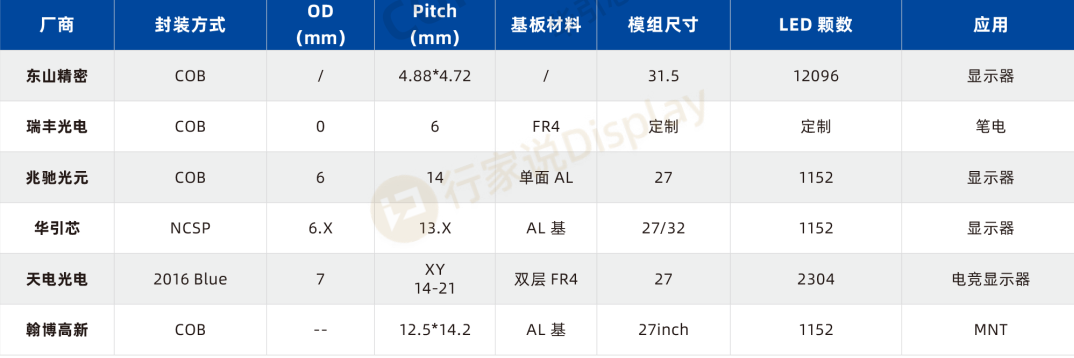
Source: Industry Research “2024 Mini LED Backlight and Automotive Research White Paper”
03
Technology Further Promotes Product Upgrades
With breakthroughs and innovations in Mini LED backlight technology, new functions such as dynamic area backlight control and higher brightness output are expected to be developed, providing users with better display effects.
Backlight Partitioning Reaches Bottleneck
Loading…
Backlight partitioning has long been one of the key technologies focused on Mini LED backlight displays. The higher the number of partitions, the greater the improvement in picture quality. In 2024, Mini LED backlight partitioning has reached tens of thousands, and the marginal effect of solely increasing partitions on picture quality has become evident, reaching a bottleneck.
Halo Control Technology Upgrade
Loading…
Mini LED TVs adopt multi-partition backlighting, where each partition can be controlled to turn on or off individually. However, even with strict control of multiple small backlight partitions, when displaying high-contrast images, the light between partitions still affects each other, leading to halo effects.
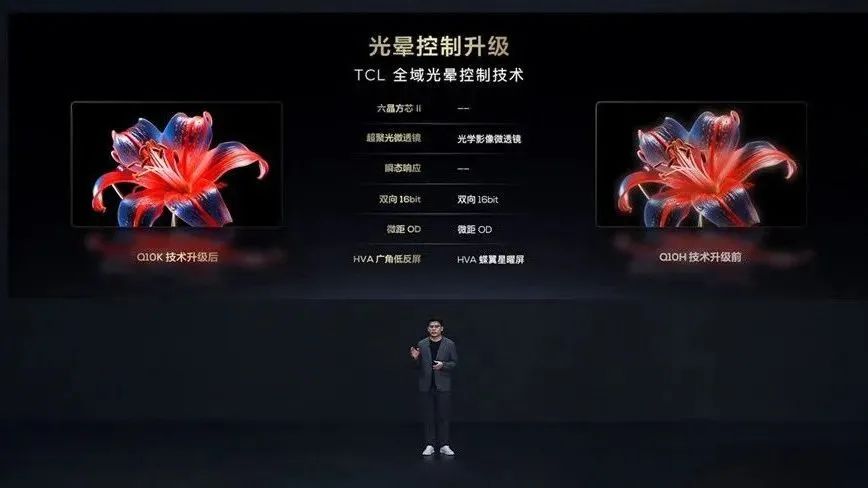
Source: TCL New Product Launch Conference
The more partitions a Mini LED TV has, the more independently controlled areas it has, and the halo issue becomes a key factor affecting picture quality. By the end of 2024, TCL’s QD-Mini LED technology product will adopt its multi-partition technology, effectively improving the halo phenomenon of Mini LED products through brightness enhancement of the light-emitting chips and comprehensive upgrades of control algorithms, further enhancing display quality.
AI Empowers Mini LED
Loading…
Looking back at 2024, the integration of Mini/Micro LED with AI technology has become increasingly close, and the fusion of the two may become an important trend in the future development of display terminal products.
2024 AI + Mini LED TV New Products (Incomplete Statistics)
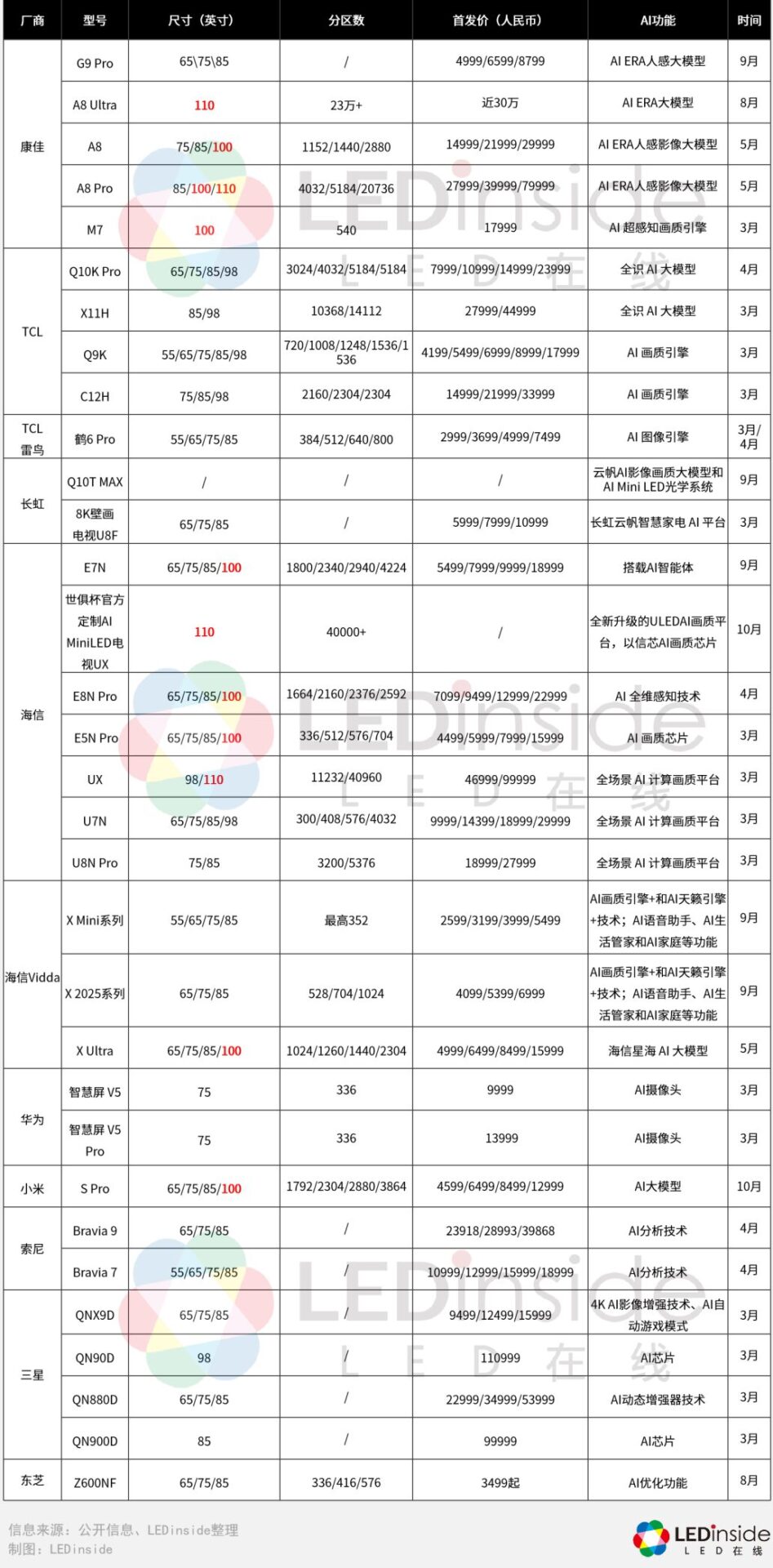
Part 03.
COB Continues to be Optimistic
2024 Mini LED Expansion Direction
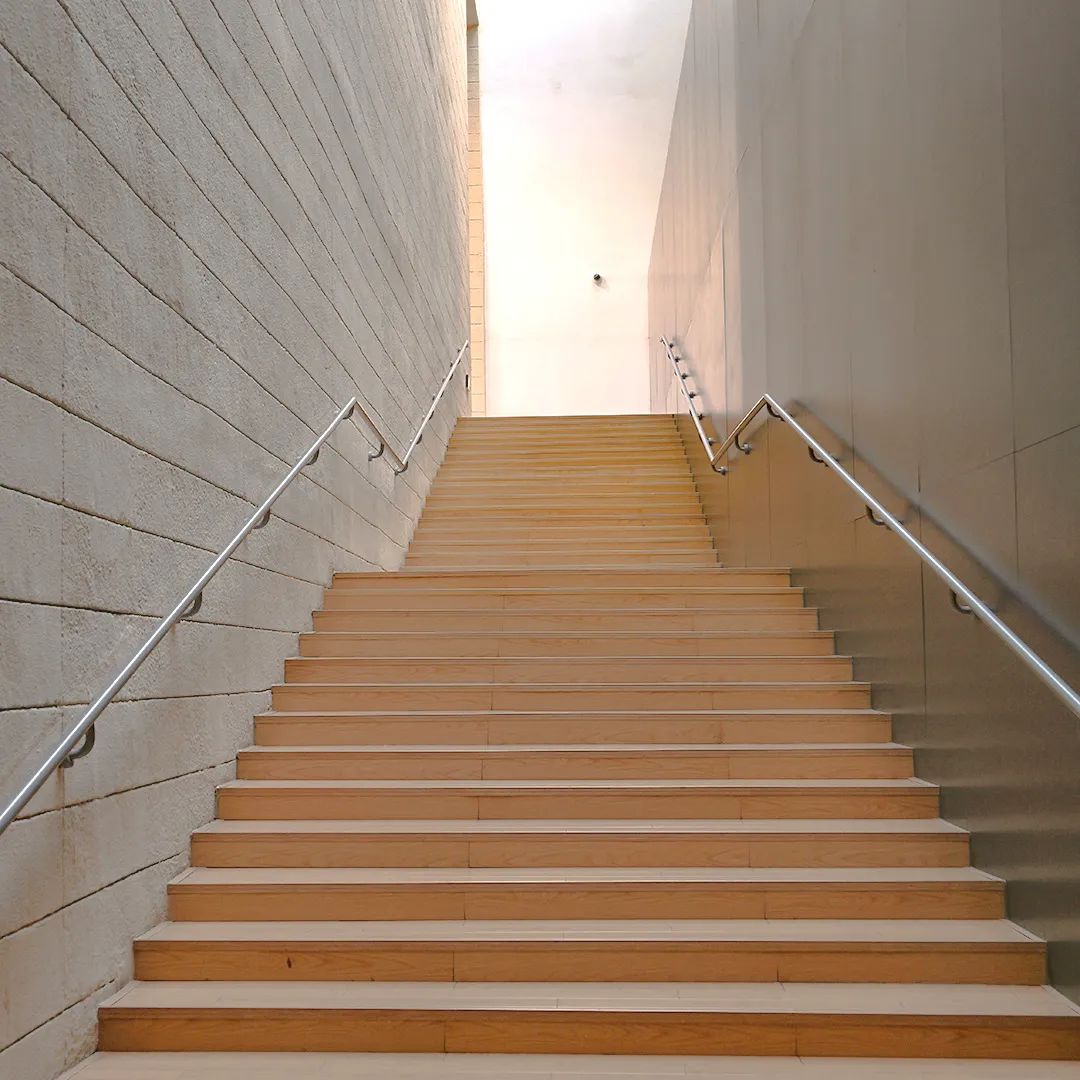
POB, as the most widely used packaging technology currently, has the advantage of high maturity and can meet the packaging requirements of most application industries. However, it also has obvious drawbacks, such as the thickness of the backlight module, which cannot achieve thinness.
On the other hand, COB, as a type of bracket-free integrated packaging technology, has characteristics such as thinness, good heat dissipation, and high reliability, making it easier to meet the display optical system’s requirements for ultra-thin, high color gamut, and high brightness. It is widely regarded as one of the development directions of next-generation display optical packaging technology.
In fact, in 2024, there is a saying in the industry “COB Universal Theory” – the present of COB is Mini LED, the future of COB is Micro LED, and in the intermediate stage, COB can also be MIP.
01
COB – Core Hotspot in Mini/Micro LED Industry
Mini LED COB technology is applied in both backlight and direct display markets. After years of development, the Mini LED COB technology route has basically been determined, with products evolving towards larger substrates, smaller pixel pitches, and continuously decreasing prices, leading to increasingly fierce industry competition.
In terms of backlighting, the continuous increase in demand is driving manufacturers to expand capacity. According to the “2024 Mini LED Backlight and Automotive Research White Paper” by Industry Research, nearly 20 Mini LED backlight projects have entered the construction and expansion stages between 2023 and 2024, with several projects focusing on COB backlight products.
2023-2024 Mini LED Backlight Project Progress
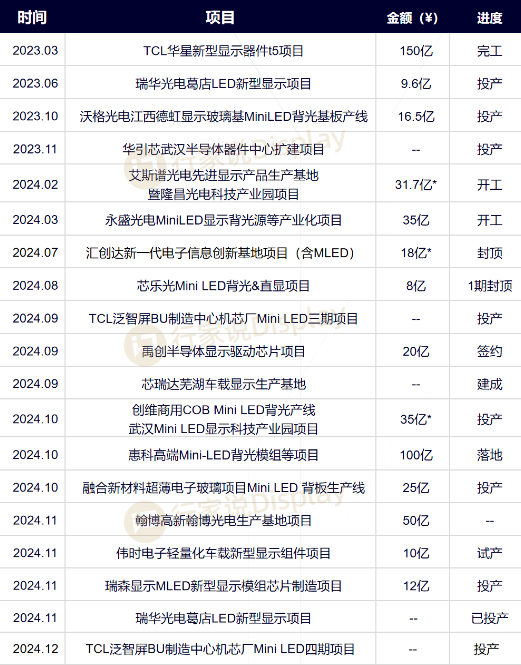
Source: Industry Research “2024 Mini LED Backlight and Automotive Research White Paper”
With the expansion of production capacity, it is beneficial for manufacturing costs to decrease. Data shows that the price of COB backlight packaging components has dropped from 48,000 RMB/㎡ (based on P1.25) in 2018 to 9,000 RMB/㎡ in 2024, maintaining a quarter-on-quarter decline of 3-5% each quarter in 2024.
In terms of direct display, the overall production capacity of the industry is also being enhanced simultaneously. According to relevant statistics, as of October 2024, the production capacity of Mini LED COB direct display equipment is about 70,000 ㎡/month (based on P1.25), with actual shipment volume around 40,000 ㎡/month, which is three times the average monthly shipment of 10,000 ㎡ in 2023.
This shows that whether in backlighting or direct display, the prices of Mini LED COB products are showing a downward trend year by year, greatly broadening the market capabilities of COB technology in the display industry, directly increasing customer types and scales, and promoting the accelerated development of COB.
02
CSP – New Players Emerge, Industry Bets Increase
In addition, CSP is also one of the trends in Mini LED backlight packaging technology this year.
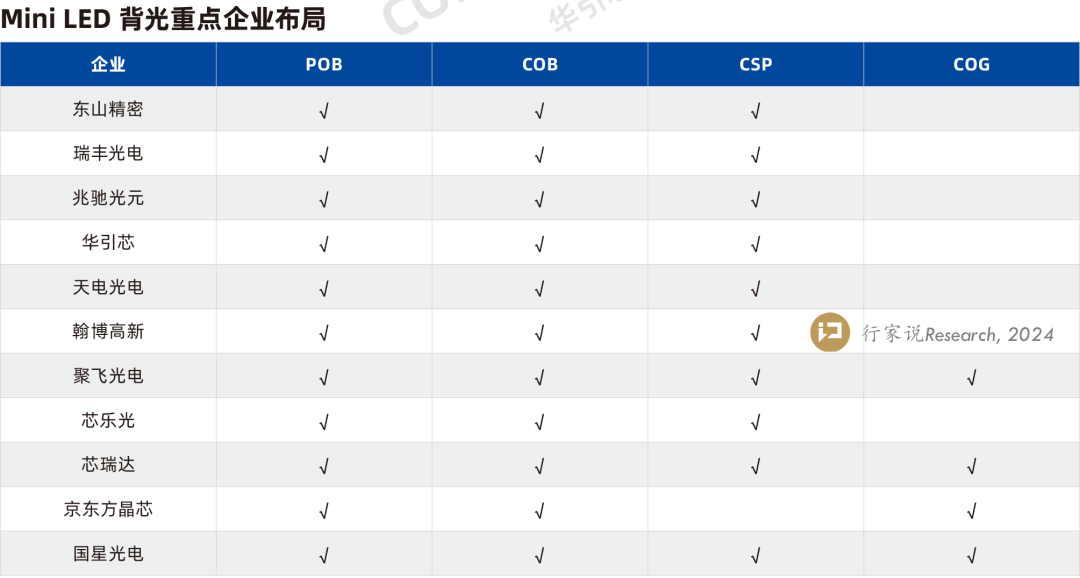
Source: Industry Research “2024 Mini LED Backlight and Automotive Research White Paper”
CSP technology in the Mini LED field mainly reflects its ability to achieve higher integration, smaller packaging volume, and lower thermal resistance, thereby improving display effects and reducing overall system costs.
From the perspective of the terminal market, in TV applications, CSP combined with high-voltage chips, irregular PCB boards, and other cost-reduction paths are promoting the large-scale application of Mini LED in low-partition products. In automotive applications, CSP avoids the instability effects brought by subsequent QD films, promoting the entry of Mini LED products into the automotive backlight market.
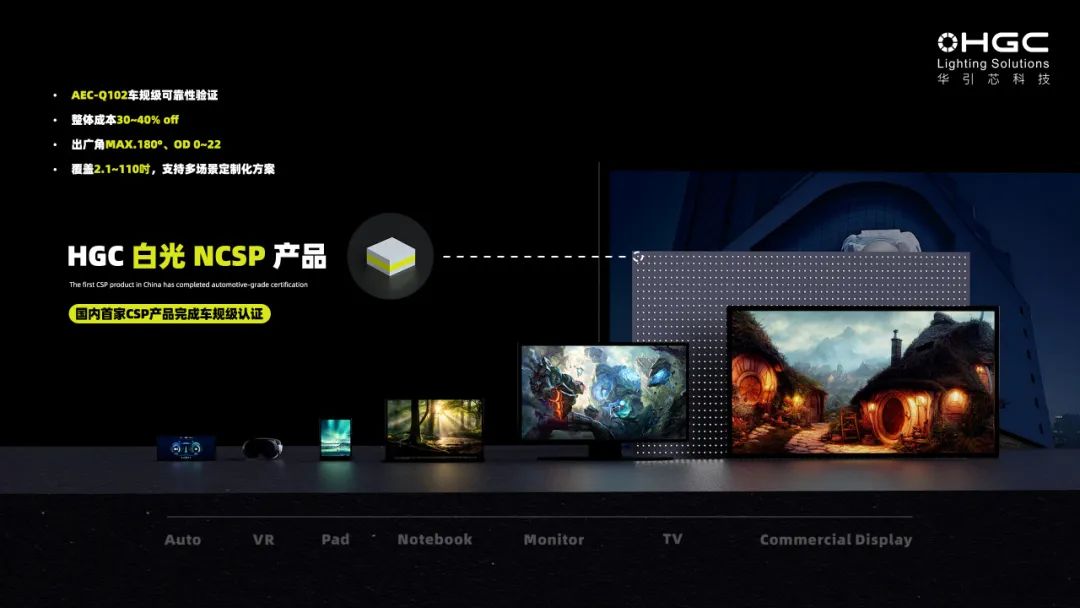
Source:Huayin Technology Official Website
NCSP, as a form close to CSP, has also achieved rapid development this year. Represented by Huayin Technology, a leader in Mini LED technology innovation, its independently developed NCSP white light Mini LED backlight technology solution has laid out a product matrix covering different mixing distances OD0~OD22, fully covering mainstream terminal sizes from 2.1 to 110 inches and flexibly applied in VR, AUTO, MNT, TV, and other fields.
Conclusion
The Future is Here, and the Arrival is Imminent
Any new technology, from emergence to maturity and then to industrialization, often undergoes a long iterative cycle, and Mini LED is no exception.
After nearly years of development, in 2024, Mini LED has seen qualitative leaps in terms of technical solutions, equipment production capacity, and terminal market performance compared to previous years, gradually entering a mature stage. For many domestic manufacturers that heavily invested in Mini LED earlier, this can be seen as the first light of dawn.
The next step for Mini LED will be to face the issues of industrialization and scaling, requiring the entire industry chain to work together. Observing from upstream raw material supply (such as chips, light beads, PCBs, driver ICs, etc.) to midstream packaging and modules, and downstream application fields, many well-known domestic manufacturers have accelerated their entry. The future is here, and the arrival will not be long.
References and Supplementary Materials
Projection Era: 2024 Mini/Micro LED Application Technology Trend Summary: Expectation and Innovation Dance Together
Industry Research: 2024 Mini LED Backlight and Automotive Research White Paper
Disclaimer: This article is for learning and exchange purposes only. Some of the graphic and textual materials in the article are sourced from publicly available channels on the internet, and the copyright belongs to the original authors. If there is any infringement, please contact for deletion.